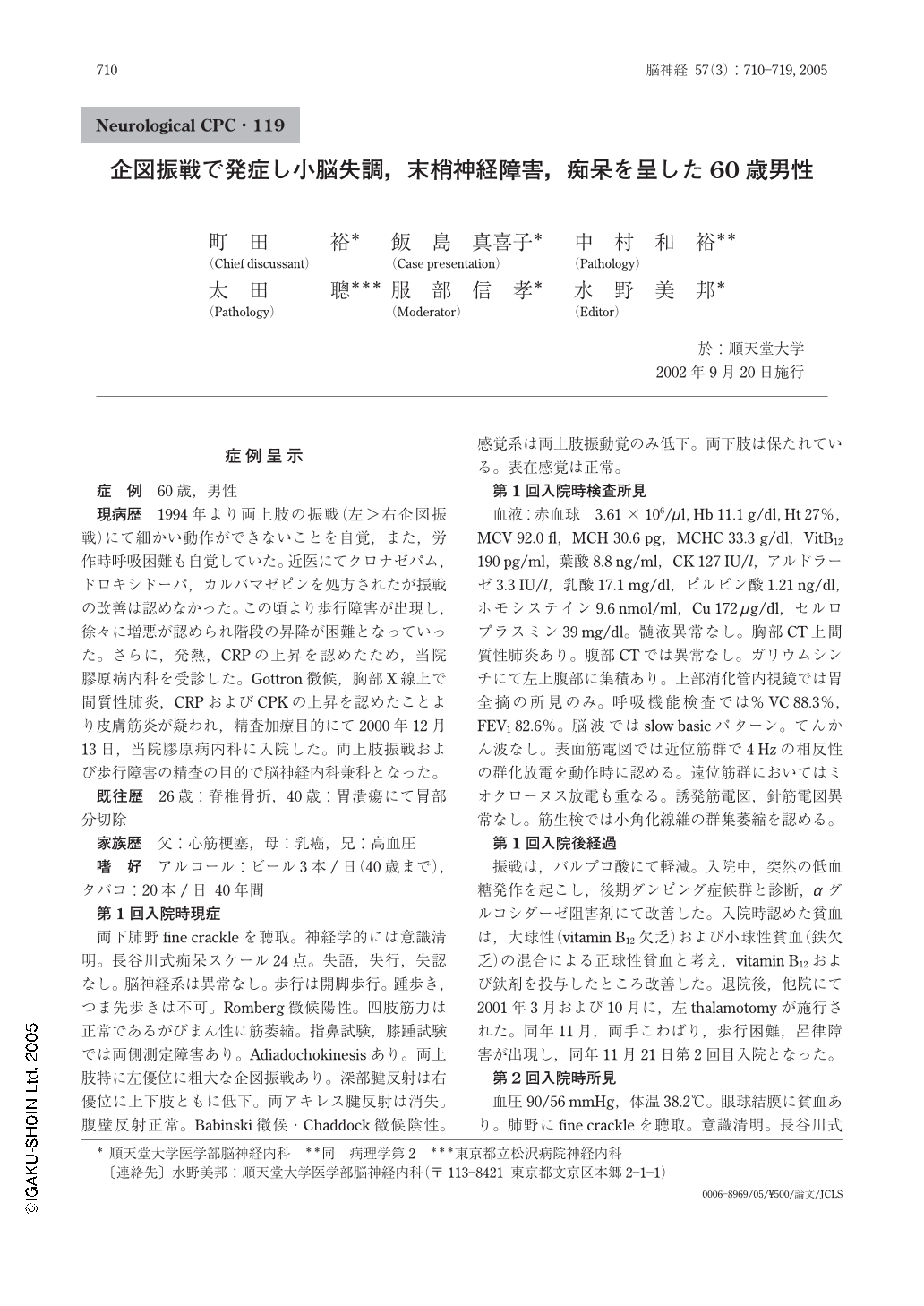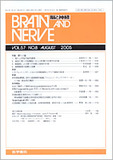Japanese
English
- 有料閲覧
- Abstract 文献概要
- 1ページ目 Look Inside
症例呈示
症 例 60歳,男性
現病歴 1994年より両上肢の振戦(左>右企図振戦)にて細かい動作ができないことを自覚,また,労作時呼吸困難も自覚していた。近医にてクロナゼパム,ドロキシドーパ,カルバマゼピンを処方されたが振戦の改善は認めなかった。この頃より歩行障害が出現し,徐々に増悪が認められ階段の昇降が困難となっていった。さらに,発熱,CRPの上昇を認めたため,当院膠原病内科を受診した。Gottron徴候,胸部X線上で間質性肺炎,CRPおよびCPKの上昇を認めたことより皮膚筋炎が疑われ,精査加療目的にて2000年12月13日,当院膠原病内科に入院した。両上肢振戦および歩行障害の精査の目的で脳神経内科兼科となった。
既往歴 26歳:脊椎骨折,40歳:胃潰瘍にて胃部分切除
家族歴 父:心筋梗塞,母:乳癌,兄:高血圧
嗜 好 アルコール:ビール3本/日(40歳まで),タバコ:20本/日 40年間
第1回入院時現症
両下肺野fine crackleを聴取。神経学的には意識清明。長谷川式痴呆スケール24点。失語,失行,失認なし。脳神経系は異常なし。歩行は開脚歩行。踵歩き,つま先歩きは不可。Romberg徴候陽性。四肢筋力は正常であるがびまん性に筋萎縮。指鼻試験,膝踵試験では両側測定障害あり。Adiadochokinesisあり。両上肢特に左優位に粗大な企図振戦あり。深部腱反射は右優位に上下肢ともに低下。両アキレス腱反射は消失。腹壁反射正常。Babinski徴候・Chaddock徴候陰性。感覚系は両上肢振動覚のみ低下。両下肢は保たれている。表在感覚は正常。
第1回入院時検査所見
血液:赤血球 3.61×106/μl,Hb 11.1g/dl,Ht 27%,MCV 92.0 fl,MCH 30.6 pg,MCHC 33.3g/dl,VitB12 190 pg/ml,葉酸8.8 ng/ml,CK 127 IU/l,アルドラーゼ 3.3 IU/l,乳酸17.1mg/dl,ピルビン酸1.21 ng/dl,ホモシステイン9.6 nmol/ml,Cu 172μg/dl,セルロプラスミン39mg/dl。髄液異常なし。胸部CT上間質性肺炎あり。腹部CTでは異常なし。ガリウムシンチにて左上腹部に集積あり。上部消化管内視鏡では胃全摘の所見のみ。呼吸機能検査では%VC 88.3%,FEV1 82.6%。脳波ではslow basicパターン。てんかん波なし。表面筋電図では近位筋群で4 Hzの相反性の群化放電を動作時に認める。遠位筋群においてはミオクローヌス放電も重なる。誘発筋電図,針筋電図異常なし。筋生検では小角化線維の群集萎縮を認める。
第1回入院後経過
振戦は,バルプロ酸にて軽減。入院中,突然の低血糖発作を起こし,後期ダンピング症候群と診断,αグルコシダーゼ阻害剤にて改善した。入院時認めた貧血は,大球性(vitamin B12欠乏)および小球性貧血(鉄欠乏)の混合による正球性貧血と考え,vitamin B12および鉄剤を投与したところ改善した。退院後,他院にて2001年3月および10月に,左thalamotomyが施行された。同年11月,両手こわばり,歩行困難,呂律障害が出現し,同年11月21日第2回目入院となった。
第2回入院時所見
血圧90/56mmHg,体温38.2℃。眼球結膜に貧血あり。肺野にfine crackleを聴取。意識清明。長谷川式痴呆スケール17点。脳神経系では眼球運動は両側上方視,および左眼外転制限あり。聴力は左で低下。舌萎縮あり。歩行,起立は不能。Romberg徴候陽性。四肢筋力は上腕および前腕は左優位に4/5程度の低下。手指は背側骨間筋,掌側骨間筋は両側3/5。下肢は両側大腿筋群4/5,下腿筋4/5,長母指伸筋3/5,長指伸筋4/5,短母指屈筋3/5,長指伸筋4/5。両上肢ジストニア姿位および企図振戦あり。指鼻試験,膝踵試験では両側測定障害あり。深部腱反射は全てで低下。腹壁反射陰性。口尖らし反射陽性。表在感覚正常。振動覚は両下肢で低下。
第2回入院時検査所見
白血球8,200/μl,赤血球3.61×106/μl,Hb 9.5g/dl,Na 131mmol/l,Cl 95mmol/l,総蛋白5.5g/dl,アルブミン2.9g/dl,GOT 79 IU/l,GPT 69 IU/l,LDH 1,145 IU/l,可溶性IL2-receptor 1,200 U/ml,遺伝子検査はSCA1,2,3,6,7,8,12,DRPLAに対し陰性。血清抗Hu,Yo,Ri抗体は陰性。胸部CTで右上葉に1 cm大の淡い異常陰影,胸水貯留,大動脈周囲リンパ節腫大あり。腹部CTでは空腸に5×10 cmの腫瘍あり。ガリウムシンチグラフィーでは肝下面の右上腹部に強い集積あり。表面筋電図では姿勢時に上肢に約3 Hz周期で律動性相反性群化放電あり。安静時にて頻度の低下,労作時にて増悪する。誘発筋電図では左尺骨神経(運動神経)43.4 m/sec,左後頸骨神経35.9 m/sec,左深腓骨神経26.0 m/sec,左腓腹筋神経導出不可。
第2回入院後経過
可溶性IL-2 receptor上昇,小腸腫瘍であることから悪性リンパ腫を疑った。全身状態が不良であり,開腹生検が困難であったためCTガイド下生検を施行したところ小腸癌(anaplastic carcinoma)と診断された。小腸癌の治療法としては手術が唯一の治療法であるが,一度開腹手術をしていること,確定診断時には全身状態が非常に悪かったことから,対症療法で対応することとした。しかし,胸水の貯留が高度となり肺水腫を合併し急激に呼吸状態が悪化,多臓器不全となり2002年2月10日午後9時1分に死亡。
We report a 60-year-old man with a 6-year history of tremor in his hands. He noted the onset of short of breath and gait disturbance in 1994 ; both of these symptoms were slowly progressive. Then recently he developed fever two months prior to the present admission. He was admitted to the rheumatology department of our hospital and neurological consultation was asked on December 13, 2000.
On neurologic examination, he showed Gottron sign and fine crackle in both lungs. Pertinent neurological findings were bilateral dysmetria in finger-to-nose and heel-to-knee tests and a broad-based gait. In addition, he showed intention tremor in upper extremities more on the left. Romberg sign was positive. Deep tendon reflexes were decreased. Vibratory sensation was reduced at the wrists. The patient's hemoglobin was 11.1g/dl, with a mean corpuscular volume of 92.0 fl. Vitamin B12 level was 190(reference range, >230 pg/ml). Serum lactic acid, pyruvic acid and ceruloplasmin were slightly elevated. Chest X-ray showed interstitial pneumonia. Muscle biopsy showed grouping of small angular fiber. Brain MRI showed diffuse atrophy of the cerebral cortex and the cerebellum hemisphere. Thalamotomy did not improve his tremor. He was admitted again in November 2001. General worsening of his neurological findings was observed. IL2-receptor was markedly elevated. Serum anti-Hu, Yo and Ri antibodies were negative. An anaplastic carcinoma was found in his jejunum. He died from respiratory failure in February 2002.
He was discussed in a neurological CPC and the chief discussant arrived at a conclusion that the patient had paraneoplastic syndrome. Other diagnosis entertained included MERRF, GSS, Ramsay Hunt syndrome, subacute combined degeneration, spinocerebellar degeneration. Majority of the participants thought that paraneoplastic syndrome was most likely.
Post-mortem examination revealed poorly differentiated carcinoma in the small intestine. Myeline pallor was noted in the posterior and the lateral columns in the thoracic spine. Neuronal cell loss was observed in the Purkinje cell and granular cell layer in the cerebellum. Sural nerve demonstrated loss of myelinated fibers and grouping of small fibers. Neuropathological findings were consistent with Friedreich ataxia ; nevertheless, no mutation was reported in frataxin in Japan. The neuropathologist concluded that neuropathological diagnosis was a spinocerebellar ataxia with neuropathological similarities to Friedreich ataxia.

Copyright © 2005, Igaku-Shoin Ltd. All rights reserved.


